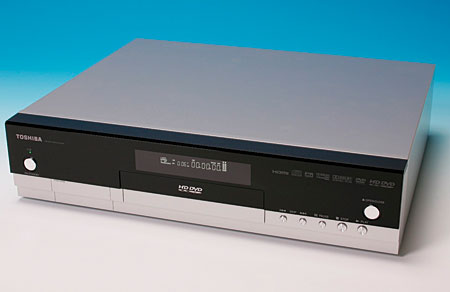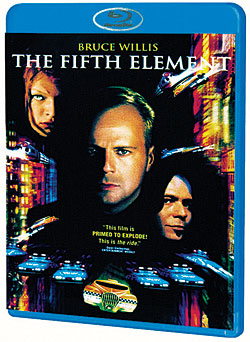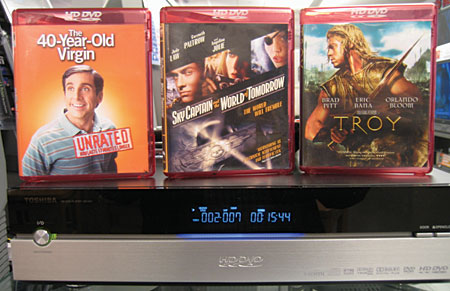HD DVD Versus Blu-ray
The next generation of prerecorded video content is here. The new machines use a blue-violet laser to read discs with far more storage capacity than current standard-definition DVD, and they can play high-definition content in full 1,920-by-1,080 resolution. The big attraction is the promise of the best picture quality you have ever seen on a display. The prerecorded, high-definition content offers pristine, near-perfect images with fewer artifacts (noise and blocking) than is possible today with broadcast or D-VHS content.

Toshiba HD-A1 HD DVD player
By the time you read this, if everything goes according to plan, HD DVD and Blu-ray players and discs should be hitting the store shelves. To dispel the confusion that will surely ensue, I will attempt to define the similarities and differences of the two formats as closely as I can discern.
Let's begin with the similarities. Each format uses 120-millimeter-diameter discs, the same size as standard-definition DVDs. Both formats' players will read SD DVDs in addition to their respective discs. However, neither will play the other's HD format. Each has the same type of 405-nanometer-wavelength blue-violet laser. HD DVD and Blu-ray are being introduced in the United States as playback-only home-deck models, although each camp plans to debut computer drives that will record and play their respective formats. These are not expected until later this year. They first need new-generation video cards and computer monitors, both with copy protection. HD DVD supporter Microsoft will also offer a new operating system, currently called Vista. Vendors will produce home recording decks, but none have announced a firm release date.
There are three different methods of squeezing huge HD programs onto a disc. The first is MPEG-2, the compression standard for broadcast television. The maximum bit rate for broadcast is 19.39 megabits per second. At this rate, the average 1080i HD broadcast is around 10 gigabytes per hour. Both next-generation DVD formats have more headroom than broadcast. HD DVD, for example, has a transfer rate up to a maximum of 36.55 mbps, almost twice that of HDTV broadcast television. Blu-ray is even faster, with a bit rate on prerecorded discs (ROM) of up to 54 mbps. These higher rates mean better, cleaner images. In addition, there are two other compression methods for squeezing more into the same space. These are called MPEG-4 (also known as H.264) and VC-1 (also known as WM9). These two methods are more advanced and more robust than MPEG-2 (according to their respective proponents), requiring lower transfer rates to achieve the highest-quality, full-resolution high-definition pictures. An HD DVD demo disc encoded in VC-1 and provided by Toshiba has an average bit rate of just 12 mbps.
HD DVD and Blu-ray players are capable of providing enhanced menus, multiple layers, multiple Dolby Digital and DTS audio formats, and commentary tracks with the actor or director's image overlaid. Both formats can also connect to the Internet for downloads of new movie trailers, bonus content, and games, although not all Blu-ray players will have Internet connectivity. (All announced HD DVD players will.)
Both formats' discs will be able to hold a standard-definition version of the material, as well as the HD one. A Warner spokesperson has indicated that they plan to introduce new releases as dual discs (DVD + HD DVD). Blu-ray has demonstrated dual discs, but no studio has yet to announce availability.
Film-based HD content on either format will be recorded as 1080p/24, according to sources from both camps. At the moment, though, only Blu-ray has players that will output this format natively. Reportedly, there is no filtering in the 1080i output of HD DVD, and all film-based content will be flagged to provide a 3:2 output cadence. If the display device properly deinterlaces 1080i film-based content, the resulting image from either a 1080p/24 or 1080i output should look nearly identical. (For more on deinterlacing and HD resolutions, see our feature in the March 2006 issue or at www.hometheatermag.com.)
Le Difference: Physics and Capacity
The differences are in the details. While both disc formats create high-definition images, the discs themselves are slightly different. With HD DVD, the layer where the information is recorded is 0.6 millimeters into the disc. Blu-ray's layer is only 0.1 mm deep. Blu-ray originally needed a protective caddy, but new coatings make it unnecessary. Both formats use pits in a reflective layer to store the digital data. The pits are smaller in the Blu-ray format, resulting in a larger storage capability per layer. A single-layer read-only Blu-ray disc (ROM) used for the prerecorded content has a capacity of 25 GB. A single-layer HD DVD can store 15 GB. Dual-layer discs have been announced for both formats at 50 GB for Blu-ray and 30 GB for HD-DVD, respectively. (For more information on how this works, check out GearWorks in the September 2004 issue or at www.hometheatermag.com.) How much capacity does a disc need to achieve pristine quality, added features, and top-quality audio? That is where things get interesting; both camps are making their own claims.

Toshiba HD-XA1 HD DVD player
The Blu-ray side, led by Sony Pictures, is currently advocating MPEG-2 compression as the way to provide the highest-quality images. A Sony Pictures spokesman says that all of their initial releases will be encoded in MPEG-2, which requires more disc capacity to encode a movie. Sony and their other owned studios do not support HD DVD and do not intend to release discs in the format. Sony also owns a number of Blu-ray patents.
The HD DVD camp will be releasing most of their discs in either MPEG-4 or VC-1. According to Microsoft's HD DVD program manager, Sage Schreiner, in a published interview, "On a quality 1,920-by-1080p display, MPEG-2 will not look as good as VC-1 (or H.264)."
A Warner Home Video executive told me that their titles would be encoded with the same compression scheme for either format and at the same maximum bit rate, so the image quality should be the same with the discs they supply in both formats. Warner has indicated that their discs will all be encoded with VC-1.
A 15-GB single-layer disc can store more than 4 hours' worth of content and more than 8 hours on a double-layered disc using VC-1 or MPEG-4.
So, which disc format provides the best image quality? Ultimately, the jury is still out until we can compare them side by side. But, on paper, the same title on either format will likely look similar.
Output Resolution
The initial HD DVD players (from Toshiba and RCA) will have a maximum output of 1080i, although next-generation players are expected to incorporate 1080p output (using an HDMI output). The first Blu-ray players from Samsung and Pioneer will output 1080p. This is useful for the handful of set owners who have displays that will accept and display a 1080p signal.
Copy Protection
Both formats have approved the use of Advanced Access Content System (AACS) for their main copy-protection system. Simply put, you will not be able to make disc copies of prerecorded HD movies. In addition, both formats incorporate HDCP on their digital HDMI outputs. The Blu-ray Association has approved a second encryption layer called BD+. Fox Studios mandated this second layer as a condition to release their content on a high-definition disc format.
The BD+ system is a dynamic encryption scheme. In other words, if some hacker compromises the security, it can be updated. The AACS system is also dynamic, but, used alone, it is apparently just not sufficient for Fox.
The AACS system within each prerecorded disc contains an optional flag (called Image Constraint Token or ICT) to control the resolution on a player's analog output. At each movie studio's discretion, if the flag is activated, each format's players, via component video outputs, would max out at 960 by 540, exactly one-fourth of the resolution. This would mean that the millions of HDTV owners without HDMI (or DVI/HDCP) inputs would not be able to view their content in full resolution. Fox, Paramount Disney, and Sony Pictures (and therefore MGM) all say they will not enact the down-rez flag on their releases, at least for now.
 For the consumer, the extra layer of copy protection has no advantage. If you own a display without a copy-protected digital video input (DVI or HDMI), there will obviously be an advantage to purchasing content on which the respective studios leave the down-rez flag off.
For the consumer, the extra layer of copy protection has no advantage. If you own a display without a copy-protected digital video input (DVI or HDMI), there will obviously be an advantage to purchasing content on which the respective studios leave the down-rez flag off.
Cost
There are two sets of expenses for each format: the hardware and the software. I'll start with the software. Sony Pictures has announced the wholesale price of Blu-ray discs with a cost to retailers of $17.95 for catalog titles (meaning old releases) and $23.45 for new releases. At press time, the only announced retail price is for the film Chronos (independent studio). It has the same MSRP of $24.98 for either HD DVD or Blu-ray at Amazon.com. The manufacturing cost of discs, according to published reports, are lower for HD DVD because it uses existing SD DVD manufacturing equipment (with some modifications). The Blu-ray camp has reportedly said the cost advantage of HD DVD will disappear within a few years as production volumes ramp up.
The hardware costs consist of royalties and the cost of materials and labor. The materials and labor should cost about the same, since the major components, such as the blue laser, the MPEG-2/VC-1/
MPEG-4 decoder chip, and the HDMI output circuitry are essentially the same for both formats. The largest variable cost appears to be in the intellectual property (IP). The Blu-ray disc (BD) format uses IP owned by core members of the BD Association, plus the interactive portions known as BD Java (BD-J), which is owned by Sun Microsystems. A published report has placed the price of the royalty package at around $30 per BD player. By comparison, the royalties for HD DVD players have been pegged at around $12 per unit. In addition, the iHD system included in the cost of HD DVD software is owned by Microsoft and will be included within their new Vista operating system for PCs with HD DVD drives.
Currently, there is a huge retail-hard-cost difference. Toshiba has two models, both with USB and Ethernet ports for network (Internet) connectivity, for $500 (the HD-A1) and $800 (the HD-XA1).
The two Blu-ray models announced so far are the Samsung BD-1000 (no network connection) at $1,000 and the Pioneer BPD-HD1 (with network connectivity) for $1,800. What PlayStation 3 will do to the pricing of Blu-ray players and the next generation of disc players as a whole remains to be seen.
Clearly, HD DVD has a current cost advantage. Time will tell how quickly hardware prices will decline.
Manufacturer and Studio Support
The Blu-ray group showed prototypes and prospective production-model players at CES 2006 by LG, Mitsubishi, Panasonic, Philips, Samsung, Sharp, and Sony. The HD DVD promotion group displayed players by Toshiba, RCA (Thomson), and LG. Studio support falls into three categories: ones that support only HD DVD, ones that support only Blu-ray, and media companies that will supply discs in both formats.
HD DVD Only
Universal, Weinstein
Blu-ray Only
20th Century Fox, Lions Gate, Disney, Sony Pictures (includes Columbia TriStar, MGM), Miramax
Blu-ray and HD DVD
Warner Brothers, Paramount, New Line, HBO
HD DVD and Blu-ray are claiming around 40 titles each at launch and around 200 to be available for each format by year's end.

HD DVD titles
Current Studio Advantage: Blu-ray
However, if recent history is any indication of studio support, the format that wins consumers' hearts, minds, and dollars will eventually find support from the hold-out studios. Disney is an excellent example. They were very late to begin producing (standard-definition) DVDs, but they could not ignore the sales and began to offer many of their titles in the format.
If HD DVD's lower price creates far greater demand than its Blu-ray counterpart, I would suspect that Disney (along with other studios) would begin to make their respective catalogs available in both formats.
Conclusion
Based on early demonstrations of HD DVD and Blu-ray, both formats provide the best-looking high-definition images ever available to consumers. As playback media, we do not expect picture-quality differences between the two. There will be format-based distinctions for the operation, the look of graphics and special features (interactivity), and, later, when ready, the "managed copy," or the ability to move content around the home or to other devices (such as a PC or hard-drive recorder, an issue for a future discussion).
Boiling it down, Blu-ray offers more storage, which will enhance its value as a game- and computer-data-storage media but may or may not be of significance as a prerecorded format. Initially, the prices of players will be higher for Blu-ray when compared with HD DVD. Again, this difference may disappear when Sony's PlayStation 3 appears with Blu-ray playback. More movie studios have said they will offer content on Blu-ray, although (as announced) the number of titles available through 2006 will be about the same for both formats.
HD DVD will get you in the game for as little as $500 at introduction and may gain significant sales momentum—and additional support from hardware makers and studios if the HD DVD camp can maintain the price differential it has against Blu-ray. I anticipate that things will heat up very quickly, so stay tuned.




























































